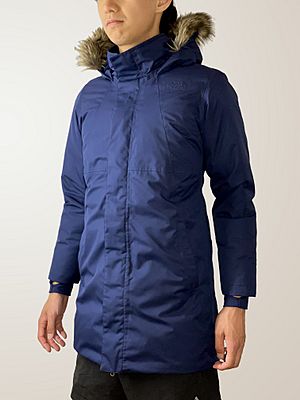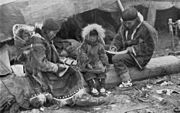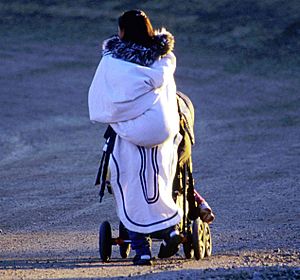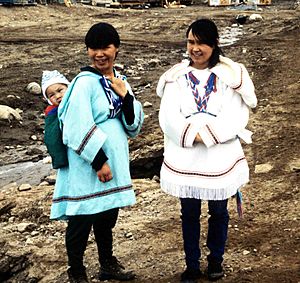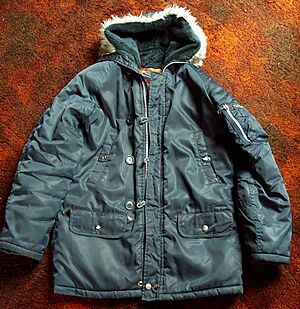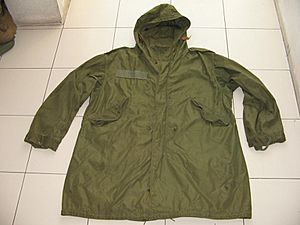Parka facts for kids
A parka or anorak is a special kind of coat that has a hood. These coats are often lined with warm fur or fake fur. Parkas are very important clothing for the Inuit people. They traditionally made them from caribou or seal skin. These warm coats helped them stay safe while hunting and kayaking in the super cold Arctic. Some old Inuit anoraks even needed to be coated with fish oil to keep water out!
The words anorak and parka are often used for the same thing, but they can be a bit different. An anorak is usually a waterproof jacket that you pull over your head. It doesn't have a front opening. A parka is a warm coat that reaches your hips. It's often filled with soft down or warm man-made materials. Parkas also usually have a fur-lined hood.
Contents
Where Did the Names Come From?
The word anorak comes from the Greenlandic word annoraaq. It first appeared in English in 1924. Back then, it was described as a special beaded item worn by Greenlandic women. In the 1950s, anoraks were made from nylon. By 1959, they were made from poplin and even featured in Vogue magazine as a fashion item! In the United Kingdom, the word "anorak" sometimes became a slightly teasing term for people who wore them.
The word parka comes from the Nenets language. In the Aleutian Islands, it simply means "animal skin." This word first appeared in English writing in 1625.
The Inuit people, who speak Inuktitut, have many words for parkas and their parts:
| English | Inuktitut Syllabics | Roman Inuktitut | IPA |
|---|---|---|---|
| woman's parka | ᐊᕐᓇᐅᑎ | irnauti | [iʁ.na.u.ˈti] |
| parka tail | ᓂᖏᒻᓇᖅᑐᖅ | ningimnaqtuq | [ni.ŋim.naq.ˈtuq] |
| parka hood | ᐊᒪᐅᑦ | amaut | [a.ma.ˈut] |
| parka decoration | ᑰᑦᓯᓂᕈᑎ | kuutsinaruti | [kuːt.si.na.ʁu.ˈti] |
| parka material | ᐊᑎᒋᑦᓴᖅ | atigitsaq | [a.ti.ɣit.ˈsaq] |
| parka button | ᓇᑦᑐᕋᖅ | naturaq | [nat.tu.ˈʁaq] |
| parka belt | ᑕᑦᓯ | tatsi | [tat.ˈsi] |
- Inuit Parkas
Amauti
The amauti (pronounced ah-MAH-tee) is a special kind of parka worn by Inuit women in the eastern parts of Northern Canada. It's designed to carry a baby safely and warmly on the mother's back. The amauti has a built-in pouch just below the hood where the baby can snuggle. Babies can stay in this pouch until they are about two years old.
The pouch is big and comfy for the baby. A mother can easily move her child from her back to her front for feeding or for quick potty breaks, all without exposing the baby to the cold weather. This traditional Inuit parka keeps the child safe from frostbite, wind, and cold. It also helps mothers and babies feel close and connected.
How the Amauti is Made
Amautiit (that's the plural for amauti) can be made from different materials. These include sealskin, caribou skin, or thick wool cloth called duffle. Often, they have a windproof outer layer.
Even today, children are commonly carried in amautiit in Inuit communities in Nunavut and Nunavik. You might also see them in the Northwest Territories, Greenland, Labrador, the Russian Arctic, and Alaska. Over time, amautiit made from cloth have become more common than those made from animal skins.
Where the Baby Sits
Many people who see an amauti for the first time might think the baby is carried in the hood. This isn't true! The hood is made larger so that both the child and mother can be covered together. The baby actually rides in the enlarged back part of the garment, in the special pouch.
The child sits with their tummy against the mother's back and their knees bent. A tie or belt around the mother's waist keeps the baby from slipping down from the pouch. The weight of the child is supported by the shoulders of the amauti. Two more ties form a "V" shape from the collarbone, connecting to the waist tie, which helps spread the baby's weight.
There's also a tie attached to the front edge of the hood. This lets the mother open the hood so a curious child can peek out and see what's happening. Or, she can pull the hood closed to protect the child from wind and bad weather.
Winter and Summer Amautiit
There are usually two main styles of amauti:
- Skirted style (called akulik): This style looks more like a dress. You can see two women wearing this style in the picture on the right.
- Long-tailed style (called angijuqtaujaq): This style has a longer back with a decorative, tail-like shape at the bottom. The woman in the picture on the left is wearing this style.
The shape of the hood, the decorations, and the tail shape can tell you which region an amauti comes from. Winter amautiit often have solid color stripes on the sleeves and hem. These stripes highlight the garment's shape and the swing of the "tail." A classic winter amauti might have a white cotton outer layer with a darker, solid-colored duffle inner layer.
In the past, the longer amauti tails were sometimes decorated with special charms like beads, shells, or old coins. These charms were believed to attract spirits to the swinging tail, which would then protect the woman's ability to have children. However, over time, the church discouraged the use of these charms.
There are also modern summer amautiit, which are not shown here. These have no sleeves and less padding, making them perfect for carrying a child while berry picking or doing other summer activities. They can also be worn in winter under a larger parka that covers both mother and baby. Summer amautiit are usually made from quilted cloth and come in many different patterns.
Amauti as Art and Style
The amauti is not just practical; it's also a beautiful piece of clothing and art. In 2007, an amauti decorated with beads by Ooloosie Ashevak, who is related to the famous Inuit artist Kenojuak Ashevak, was sold at an auction for a lot of money. It was expected to sell for much less, but it ended up selling for $19,200! This shows how much people value the craftsmanship and cultural importance of the amauti.
The Snorkel Parka
The original snorkel parka was created in the United States in the early 1950s. It was made for military flight crews who worked in extremely cold places. This parka was designed to keep people warm in temperatures as low as -51°C (-60°F)!
It was first made with a green DuPont nylon outer shell and lining. It had wool padding until the mid-1970s. Then, the padding changed to polyester, which made the jacket lighter and even warmer. The outer material also changed to a mix of cotton and nylon.
This parka got its name "snorkel parka" because of its special hood. You could zip the hood all the way up, leaving only a small tunnel, like a snorkel, for you to look out of. This was great for very cold and windy weather. However, it also made it harder to see and hear. Earlier versions had real fur on the hood, but later ones used fake fur.
Many companies copied the basic snorkel parka design for people to buy. You can often find old military parkas for sale. They are known for being very strong and warm, built for tough conditions. In the 1970s and 1980s, civilian snorkel parkas came in many colors, like blue, green, and black. Most had a bright orange lining.
The Fishtail Parka
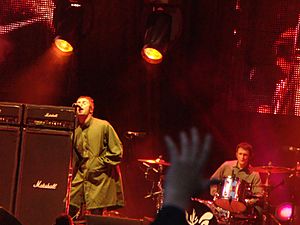
The fishtail parka was first used by the United States Army in 1950 during the Korean War. After World War II, the US army needed new warm clothes for cold weather. This led to four main types of fishtail parkas: the EX-48, M-48, M-51, and M-65. The "M" stands for model, and the number is the year it was made standard. The EX-48 was the first "experimental" version. The M-48 was the first one made for general use.
The name fishtail comes from the back of the parka. It has a long, split part that looks like a fish's tail. This part could be folded up between the legs and snapped into place. This helped keep the wind out and added warmth. You could also fold the fishtail away at the back if you needed more freedom to move.
Different Fishtail Parka Models
- EX-48 and M-48 Parkas: The EX-48 parka had a pocket on the left sleeve and was made of thin poplin. The M-48 parkas were made of heavier cotton. Both of these early models had a sleeve pocket, which later models did not. The fur on their hoods was fixed to the coat and was often wolf, coyote, or wolverine fur. The M-48 was expensive to make, so it wasn't produced for very long.
- M-51 Parka: This version was made because the M-48 was too costly. The M-51 had a hood that was part of the parka shell. It also had a separate hood liner and a main liner that could be buttoned in or out. This made it easier to clean the coat and adjust how warm it was. Early M-51s used heavy cotton, but later ones used lighter poplin. The liners also changed from heavy wool to lighter wool that dried faster.
- M-65 Parka: This was the last version of the fishtail parka. It had a hood that could be taken off completely. It also had a removable quilted liner made of modern synthetic materials like nylon and polyester. The M-65 fishtail parka started being made in 1968. After 1972, the hoods on these parkas used fake fur instead of real fur.
These parkas were designed to be worn over other layers of clothing, especially for soldiers. So, all fishtail parkas are quite big. They weren't warm enough on their own in extremely cold, dry conditions (below about -10°C or 14°F).
In the 1960s in the UK, the fishtail parka became a symbol for the mod youth culture. They were practical, cheap, and easy to find in military surplus stores. Mods wore them to protect their nice clothes from dirt and grease while riding their scooters. Pictures of parka-wearing mods during the Bank Holiday riots of the 1960s made them famous.
Cagoule
A cagoule is a British term for a lightweight, waterproof anorak or parka. It's usually not lined and sometimes reaches the knees. A cagoule can be rolled up into a very small package, so you can easily carry it in a bag or pocket. It was invented in the early 1960s by Noel Bibby. It might have a full zipper or be pulled over the head like an anorak. It always has a hood and elastic or drawstring cuffs. Sometimes, the hood itself turns into a bag for the coat when you roll it up. Cagoules became very popular in the United Kingdom in the 1970s.
See also
 In Spanish: Anorak para niños
In Spanish: Anorak para niños
- Anorak (slang)
- Capote (garment)
- Goggle jacket
- Hoodie
- Mackintosh
- Yup'ik clothing
- The Anorak, a play about the Montreal Massacre written and performed by Adam Kelly


